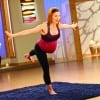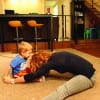In pregnancy, you need strong legs to support your growing belly. Strengthening and stretching your legs is essential, as well as stretching your hips to be open and ready for labor.
As you do these moves, take care to not over-stretch. During pregnancy, relaxin, a protein hormone, is at increased levels in your body, helping to loosen your joints for labor. It can sometimes make you feel like a super-flexy lady. Know your limits—if it feels like too much, it probably is.
Plié Squats
(main picture)
Just like the ballet move, plié squats, also referred to as sumo squats, build strength and flexibility, strengthening the glutes, quads, hamstrings and inner thighs, as well as serving as an amazing hip opener.
Learning to do a proper squat can save you from back, hip and knee pain. In a plié squat, place feet hip distance apart and rotate out from the hips about 45 degrees. This will be much more comfortable than a regular squat during pregnancy, especially as your bump increases.
As you move, keep the knees open and in the same plane as the toes. Additionally, keep your shoulders and hips stacked and resist the urge to arch your back or lean forward.
- Perform: Perform 3 sets of 10 plié squats (30 total) 2-3 days a week. On the last squat in each set, sit a little deeper to open the hips more.
- Postnatal workout with baby: Infants and toddlers love to squat. Practice your plié squats in front of your baby and he or she might just join you. You can also use baby as motivation—when you see her squatting, you do one too!
Single Leg Hinge (Deadlift)
A single leg hinge, also referred to as a single leg deadlift, strengthens and stretches glutes and hamstrings—as long as you don’t overdo it. This is a great move to fight restless leg syndrome during pregnancy.
Place one leg in front of the other in a split stance. Think of hugging your baby closer to your spine (to help activate your core), and slowly hinge forward at the hips. When you feel comfortable, lift your back leg off the floor, as you flex your back foot to help contract the leg muscles. The supporting knee should remain soft. Keep your chest lifted as you work to keep your body in one long line. You will most likely feel a stretch in the hamstring of the leg on which you’re standing.
Extend your arms to help you balance. Here again, relaxin may make you feel like you can stretch further than typical—if you feel a bit uneasy, use a chair for stability or hinge forward with both feet on the floor.
- Perform: 3 sets of 8 single leg deadlifts on each leg, 2-3 times a week. On the last hinge of each set, pulse the back leg to the ceiling for a set of 10 to get an additional booty lift.
- Postnatal workout with baby: Help baby with her balance. Have a fun contest to see who can balance longest. Enjoy a hearty, good laugh when “we all fall down!”
Straddle
The straddle stretch is ideal for stretching inner thighs, hamstrings and lower back. It’s an ideal position in pregnancy as it allows you to leave plenty of room for baby!
Extend both legs out to the corners of the room at a comfortable angle for you. Press your pelvis and hamstrings into the floor to help straighten the spine. If the position isn’t comfortable for you, try sitting on a yoga block or blanket. Slowly walk your hands out in front of you as you breathe and relax into the stretch.
- Exercise Suggestion: 3-4 reps 2-3 times a week. Walk your hands forward for a count of 10. Take deep breaths and relax the body. Walk back and sit up straight between each rep.
- Postnatal workout with baby: Put your baby in front of you as you walk your hands closer to them. When baby is big enough, you can hold his hands and take turns leaning into the straddle. Sing along to “Row, row, row your boat!”








Comments are closed.